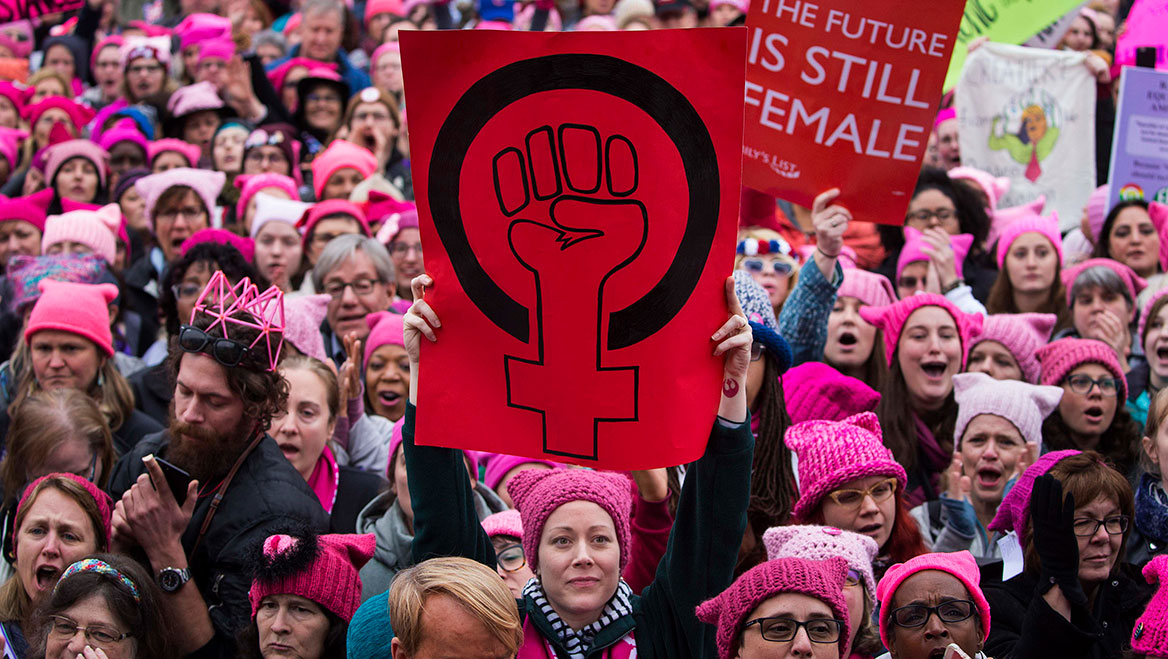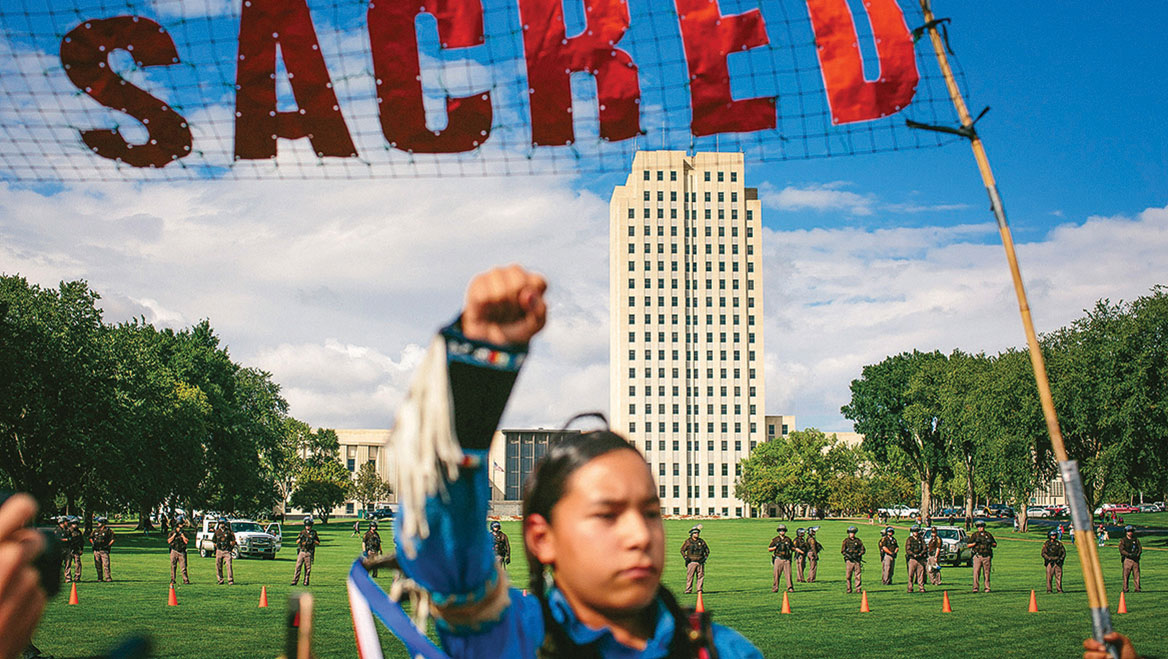Oct. 21, 2021
Temporary pop-ups of bullhorns, posterboards, and ad-hoc soapboxes can signify the power of a sudden, citizen-driven reclamation of public lands. That is often the case where Post Oak Boulevard and Westheimer Road meet, a focal point for Houston's public demonstrations. But because it is one of the busiest intersections in the city — and predominantly car-oriented — protests with as many as 3,000 people are often funneled into a narrow sidewalk space of six feet or less, with no protection from passing vehicles. Such was the case in May 2021, when the wave of rallies surrounding the Free Palestine movement drew thousands to the node's walkways that eventually spilled out into the streets.
Public spaces play a vital role in a city's infrastructure. They are our gray areas, serving as interstitial and communal markers. During the pandemic in particular, streets, parks, and plazas have not only become sources of escape, but also places for "aggrieved people to [...] express their freedom of speech," says Michael Berkowitz, founder of the nonprofit Resilient Cities Catalyst.
However, not all public spaces are built to accommodate these uses. While some U.S. cities are exploring new methods of curating city-owned lands for civic assembly, many have largely assigned them to recreation or added vehicular capacity, limiting space for demonstrations. But despite lockdowns, public spaces have served as safe havens for personal and collective healing, as well as stages to exhibit our core values. What was also made apparent is the surge of public space use that piled pressure for park agencies to safely operate, maintain, and develop opportunities for gatherings.
Reimagining public spaces for diverse needs
As we reimagine public lands in the wake of a persistent pandemic, balancing these needs and investing in public realm infrastructure, both for recreational and community uses, will be critical. Here are six ways municipalities can ensure that public assembly events are safely supported and managed through policy, design, and funding.

Three ways to accommodate civic assemblies within public domains. Graphic courtesy of Tarana Hafiz, Design Workshop.
1. Diversify the experience to cater to a variety of audiences and neighborhoods
While nationwide city park investment rose to $8 billion in 2019 (a slight increase from previous years), much of it was allocated to green spaces like Klyde Warren Park in Dallas or the Brooklyn waterfront, which prioritize programming dedicated to recreation. The most successfully designed public spaces, however, function both as vital playscapes and sociopolitical epicenters.
Emancipation Park in Houston's Third Ward neighborhood, for example, delivers much-needed respite for a historically underserved community. The 10-acre open space, purchased in 1872 by formerly enslaved people, was transformed in 2013 with refurbished playgrounds and historic buildings, in addition to a new community center and plaza. Through a rigorous co-design process with the community and years of funding advocacy, the park was established as a center for recreation, culture, and social engagement. Most effectively, the park became an incredible community asset for mobilization, as seen in 2020 when activists gathered there to call for drive-through voting.
Extensive planning and engagement are required to understand places best suited for public expression within the context of a city's open space network and how design can support them. The recently completed Downtown Colorado Springs Parks Master Plan, for instance, informed targeted investment for a stage and plaza to host civic events at the end of a soon-to-be-created half-mile pedestrian promenade that connects municipal buildings.

In Washington, D.C., a street mural at 16th Street and Lafayette Park designates the pedestrians-only Black Lives Matter Plaza. Photo by Allison C. Bailey/Shutterstock.
2. Make streets multifunctional
"Take to the streets," we hear. That's because they are signature places for citizens to express their points of view. Research shows that great civic avenues and nodes are key to socioeconomic stability and healthy city operations.
According to a 2014 report from UN-Habitat on the ideal balance of public spaces, parks should account for 15 to 20 percent of a city's total land area, with 30 to 35 percent reserved for streets. Streets can function as public assets that promote access for multiple users when designed with people in mind.
Expanding pedestrian areas along sidewalks or creating interim public plazas along the right of way offer low-cost upgrades through the use of movable furniture, epoxy gravel, or painted concrete. By reclaiming public lands oversized for motorists, we can activate spaces for performances, businesses, and social engagement. In addition, designating closures, allocating sidewalk space, and creating smooth detour plans alleviate traffic congestion and potential for collisions.
Cities can also encourage planning key corridors as temporary but designated pedestrian-only zones during large, scheduled processions. Diversity Plaza in New York City's Queens, for example, was redesigned in 2018 to close two blocks to cars and incorporate elements like seating, landscaping, and flex spaces for community events throughout the year. As a result, the street "has become Jackson Heights's de facto town square and a proud symbol of Queens as the city's most international borough," says The New York Times architecture critic Michael Kimmelman, making it attractive to both tourists craving a samosa and locals sitting around debating politics.

Cleveland's public square includes a speaker's platform and clear site lines. Photo by Cards84664/Wikipedia.
3. Integrate safety measures
Something as simple as an evacuation route indicator can serve as a vital design safety feature for large gatherings that interface with traffic flow. But building critical mass is a key function of any grand assembly. Hence, keeping huge crowds safe requires holistic site design to minimize potential conflicts rather than an overwhelming police presence.
New York City's historic Union Square Park, once a modest park for elites, was rebuilt to house a new "democratic landscape" for working class unions at the turn of the 20th century. Designers Frederick Olmstead and Calvert Vaux altered their design of the park to accommodate widened sidewalks, newly planted trees, removal of fences, and an assembly space. In other words, they made the space welcoming.
Creating parks and plazas with easy and open access, free movement of people, appropriately signed routes, good visibility across site lines, and pedestals to vary the user experience are all ways to achieve safety during protests. Cleveland's newly designed public square is a good example of a space designed for navigation, reclamation, accommodation, and visibility, with features like a city-sanctioned "speakers' platform" and an off-site staging area for emergency personnel.

Thousands arrived in Washington, D.C, for the 2017 Women's March rally on the National Mall. Photograph by Ruth Fremson/The New York Times.
4. Ensure that civic assembly spaces are part of a larger, well-connected system
Making participation accessible is key to fostering relationships between neighborhoods especially in areas that have seen considerably less investment in infrastructure and transit.
With that in mind, municipalities should consider where public lands are positioned in the grand scheme of a city's park system. Civic spaces like city halls, squares, and main streets also draw crowds during protests; participants wish to go where they can be seen, but they also want convenience.
The 2017 Women's March drew some five million participants across the country, with rallies in several borough parks in New York City alone. Developing an integrative open space and transit system that distribute people to multiple locations and provide multimodal, multifunctional options can help close the loop on access, manage overcrowding, and create a sense of unity and social resilience.

Native Americans protest the Dakota Access Pipeline near the North Dakota state capitol in Bismarck. Photo by Alyssa Schukar/The New York Times.
5. Remember that Small towns need public spaces that support demonstrations, too
While densely populated areas of the country draw more attention when it comes to large events and marches, gatherings in small towns also amplify local voices and synergize change. The Black Lives Matter movement drew widespread sit-ins and marches across the country in 2020, with more than 1,700 demonstrations across 580 cities, with hundreds in small town civic squares like Greensburg's Saint Clair Park, a small town outside of Pittsburgh with a population of only 14,000.
Creative funding streams, design opportunities, and partnerships can help create functional and aesthetic civic grounds in small towns. For more than a decade, Citizens' Institute on Rural Design, a leadership initiative of the National Endowment for the Arts, has worked in partnership with Project for Public Spaces and local residents, leaders, and designers to transform underutilized spaces into public-realm assets.
6. Support and fund a Plaza Program in your community
New York City's Plaza Program, established over a decade ago, has helped produce dozens of public squares. Overall, 55 new plazas were added across the city through cost-effective means. Expansion of Union Square resulted in 74 percent of users preferring the new configuration, with a 2.4 percent decline in traffic volume and 30 percent fewer traffic fatalities, according to the Center for Active Design (CfAD).
Baking equitable access into such a program is crucial. A proposal from the Public Space for Free Expression calls on Mayor Bill de Blasio to further expand the program to create and manage neighborhood plazas in "high-need areas" — with tandem investment in safe, well-maintained infrastructure from the Department of Transportation. The aim is to ensure that all New Yorkers are able to gather peacefully, connect, mobilize around similar issues, and feel a sense of ownership.
Research shows a significant correlation between the activation of public space and overall satisfaction in local government institutions. And despite lockdowns, the pandemic has proven that humans are social beings and crave being around others, especially to channel shared grievances against state violations. Whether municipalities reclaim more public right-of-ways for people, design plazas to be inclusive, mandate designated free speech zones across the city, or create miniature town squares at the neighborhood level, these strategies provide distinct ways to plan for socio-political dissidence. Doing so not only represents the hallmark of our society, but advances equity and inclusion goals for marginalized communities by providing a platform to identify policy failures and express essential needs.
As the Public Space for Free Expression proposal points out, a local "network of civic spaces" are not only public lands for public protests, but also grounds for "sustained community participation and engagement in the everyday." The best design and planning solutions will not only create quintessential parks for people-watching and outdoor yoga, but also transform them to organize residents towards political change, build civic trust and ownership at the grassroots level, promote equitable change for the most isolated communities, and cultivate an engaged citizenry. These multi-faceted roles of civic space are vital to the socioeconomic health of cities everywhere.




